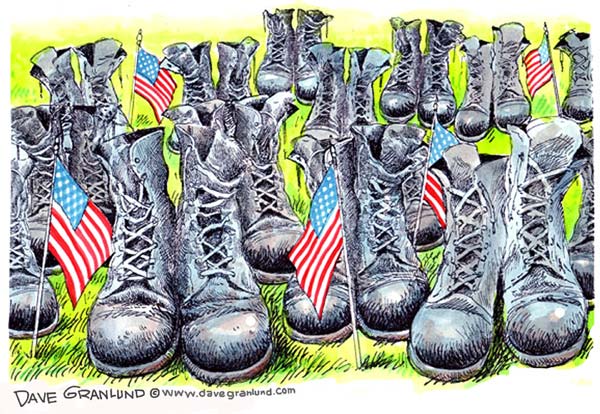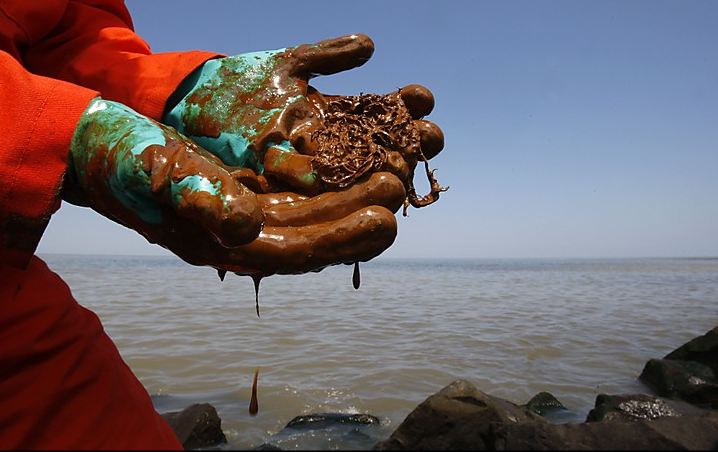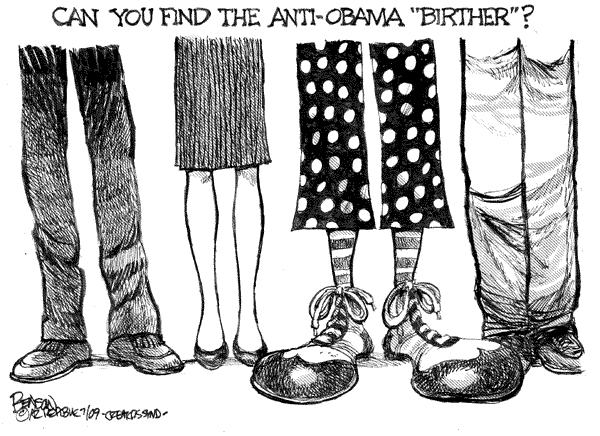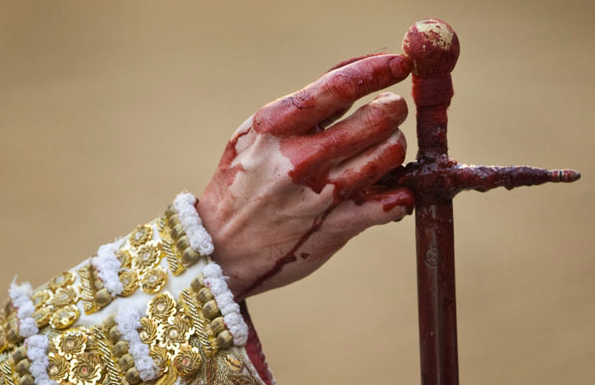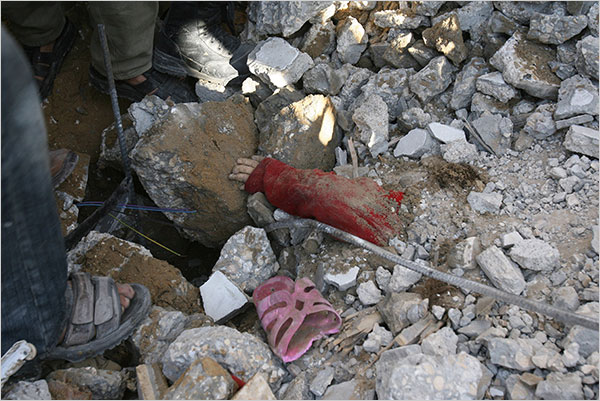Credit: Dave Granlund
A Show of Hands
We tend to think of oil as having relatively low viscosity, largely because most of us encounter it once it has been refined and readied for consumption. But here we see it as the sludge that it becomes after floating about in the gulf for several days – a gloppy, brown, glutinous mess that resembles nothing so much as tar. Notice how it clings to the protective rubber gloves and when it drips off it does so in globs that will attach to anything solid – rocks, sand, reefs, water reeds, marine life … what have you. And there are plenty of other pictures that make the point.
What I find most striking about this photograph, however, are the hands. These hands belong to a Greenpeace marine biologist testing the waters at the mouth of the Mississippi River where it meets the Gulf of Mexico, but of course we can’t tell any of that that from the picture itself. Rather, what we can tell is that it will be impossible for any of us to keep our hands clean as we deal with the environmental impact of the Deepwater Horizon accident.
The image stands in stark contrast to another photograph that appeared this past week of the Presidents and chief spokesmen for BP American, Transocean Limited, and Haliburton.
The smug expressions on their faces belie their efforts, against all credulity, to “deflect blame and responsibility for their respective companies.” But notice their hands. Folded or resting on what is probably the transcript of their prepared statements, they suggest a uniformity of indifference, perhaps even a degree of nonchalance. And note too that they are as clean as the white colors on their dress shirts. The metaphor, of course, is rich and altogether ironic. Or at least we can only hope so. If the photograph at the top of the page is correct, the sludge from Deepwater Horizon will stick to everything it touches. It would be a crime if Congress doesn’t make sure that these three all get their fair share of greasy hands.
Photo Credit: Hans Deryk/Reuters; Andrew Harrer/Bloomberg.
Cross-posted at BAGnewsNotes.
Myth and Reality in the Iraqi Election
What is it about photo editors’ obsession with inked fingers? After seeing dozens of the purple digits being offered to the camera, I want to scream “out, damned spot” and do a post on something sane–like fashion week. It is just when the media are caught up in a new craze, however, that older habits can be revealed.
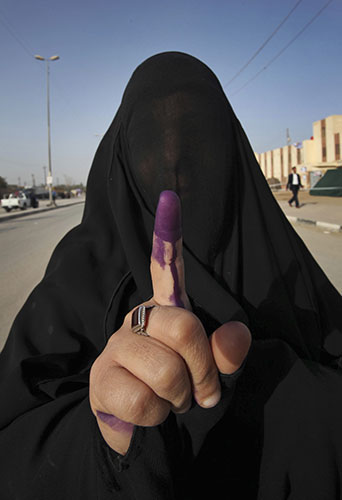
This might be the paradigmatic inked finger photo. In the foreground, direct physical evidence of democratic participation; in the background, display of the traditional, nondemocratic society that is being brought into modernity by the electoral process.
The symbolism is comprehensive: the finger signifies an individual voter and perhaps liberal individualism; the ink implies both institutional legitimacy (one person, one vote, via reliably transparent procedures) and the manner in which democratic identity might become a second skin, voluntarily painted onto the flesh. Likewise, the individual is otherwise wrapped in that society’s depersonalizing and oppressive traditions. Thus, these highly gendered and Orientalist images of veiled women are particularly useful for maintaining Western mythology about colonial occupation. The US is (and always was) there to provide democracy and other forms of emancipation, which occur when the client nation adopts Western procedures on their belated march into modernity.
Even if this were true, those in the occupation zones have always been able to see that there is another dimension to the story. The second side of modernization is revealed in this photo of another inked finger.
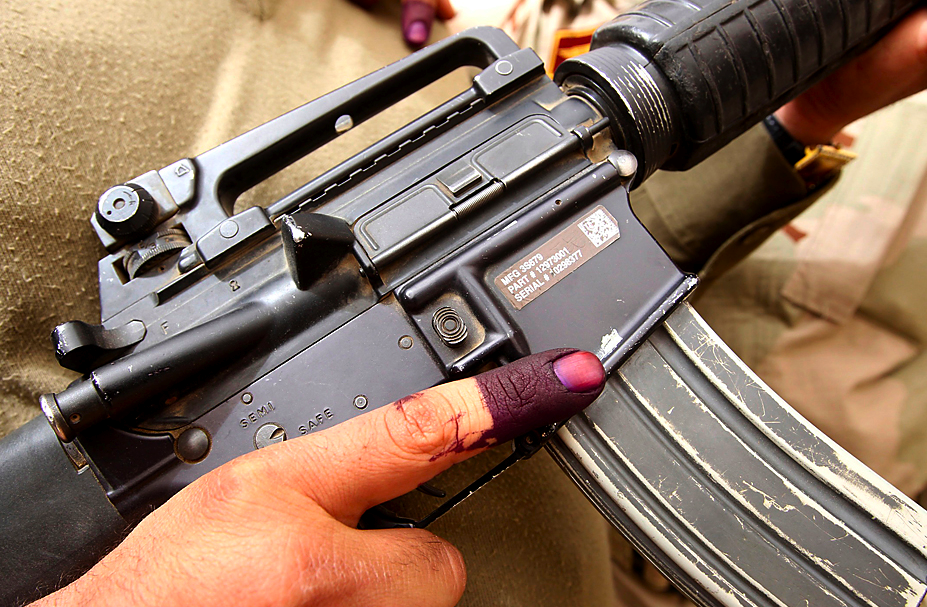
“I VOTED” began the caption for this photograph of a member of the “security personnel” in Iraq. Yes, he voted, and he also locked and loaded. Once again, we have the finger set against a backdrop, but instead of traditional costume we see a machine of the national security state. Now democracy goes hand in hand with military force. Of course, elections do need to be protected from disruption, and the state is to have a monopoly on violence, but this image of militant democratization may imply that the election is a temporary ritual while the projection of military power will remain the constant feature of national life long after the dye has washed off.
More telling is the lettering on the gun: all in English, it reminds us that the weapon was bought from-and very likely paid for by–the US. “I voted,” but the US equipped, and this election cannot escape the fact that it is still being conducted in a country stocked with US troops and on the US payroll.
The first image implies (falsely) that Iraq’s past was one of traditional Islamic repression. The second image exposes its present condition as a client state. One might hope that there can be a third alternative for the future.
Photographs by Alaa al-Marjani/Associated Press and Mohammed Ameen/Reuters.
Traces of Torture in the Visual Archive
The persistence of torture is enough to condemn modern civilization, the human race, and any conception of a just God. Any thinking, feeling human being should be ashamed at what is done, and appalled at the perversion and obscenity and stupidity that it requires, and outraged at those who fabricate lies and evasions to excuse what is always a deliberate act of horror.
It’s pitiful that there is even need to say so, and because discussion of the topic involves facing evil while risking rationalization, good people might be loathe to consider how torture can be exposed, documented, and brought to public attention and so perhaps to justice. The problem is compounded by the irony that so much of the damage done need not be visible. The ratio between harm and evidence of harm may be greater with torture than with any other form of violence, not least because of the cleverness expended in devising techniques for causing pain without leaving physical scars (American citizens might want to to think of waterboarding and sleep deprivation, for example). This is why the images collected by German radiologist Hermann Vogel provide eloquent testimony to the continuing agony and shame.
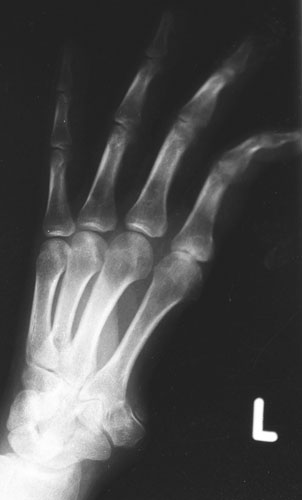
This is an X-ray of the hand of a victim from Kurdistan; after hanging from his fingers for far too long, the thumb had to be amputated. (“Clearly the work of amateurs,” a seasoned torturer might say.) I find the image to be at once beautiful and heartbreaking. The skeletal whiteness against the black void signifies a deep vulnerability, as we are at once creatures of light and yet so easily ghosted away into the void. The delicately elongated fingers suggest the incredible sensitivity of which a human hand is capable–one can easily imagine these fingers creating gorgeous music at the piano, or making an intricate ornamental pattern on paper, or gently stroking a lover’s face. All that was turned against the poor soul, however, as the same nerves were made to scream for mercy that never came. And so the missing thumb speaks to a terrible absence, not only of itself, but also of the whole hand, and the whole body and self intact, and everything else that also had to be missing–and was–for evil to occur.
As reported by articles in The Guardian, Vogel has been collected X-ray images of torture and other forms of violence for almost thirty years. This work is slowly bearing fruit, including the book A Radiologic Atlas of Abuse, Torture, Terroism, and Afflicted Trauma, and Vogel currently is lobbying the EU to allow X-ray evidence in juridical proceedings such as asylum hearings. Hearings that might offer some solace to the victims, or better yet, have saved someone from this:
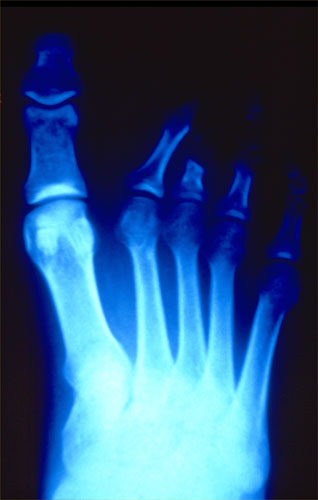
The X-ray reveals the permanent deformity produced when the toes of a 14-year-old girl were clamped by revolutionary guards in Iran. She was being punished for wearing make-up. Again, there is something touching about the image because it contains both a damaged body and a suggestion of the beauty that was broken. Perhaps the crooked foot suggests the awkwardness of the teenage years, and certainly the blue and white hue evokes the color of a young woman’s clothes and love of life. (These images obviously work in tandem with our foreknowledge of the victim’s circumstances, but that is hardly unusual.) And again, the part less damaged is still suffused with light, while the brokenness blends into the dark beyond. These images not only provide indexical signs of violence, they capture what is at stake in torture, which is nothing less than a war on all that is beautiful about human life.
It seems that evidence of trauma depends on assumptions about the formal integrity and right proportions of the human body that might be subject to criticism in some academic forums. That indites no one, but it is a reminder that, on the one hand, ethical judgments can depend on aesthetic perception and visual evidence can extend well beyond factual verification, and, on the other hand, that nothing should be taken for granted and there will be reason to develop many other resources in order to press the case against torture. In the meantime, however, one might appreciate the irony that these X-ray images, of all things, can evoke an emotional responsiveness essential to acknowledging the inhumanity of torture. In the final analysis, these photographs may be seen more as art than as evidence, but they could be all the more important for that.
Photographs collected by Hermann Vogel.
Third World Hands and the Denial of History
In Western culture and particularly in its visual arts there are strong conventions that place peasant life close to nature, in a realm of slow time that is largely impervious to historical change, and limited to the core functions of human subsistence. Obviously, none of this precludes being the subject of a striking artistic image.

This photograph from Mumbai of a potter’s hand working the wet clay is a stunning composition. The odd yet graceful configuration of the hand, the exceptional tonality of the light on the grey mud, the tension between the immobility signified by the drying mud on his hand and the continuous motion of the spinning artifact–these combine to create a richly textured image. It remains an image of a primitive world, however: we see a human body caked in the primal mud from which it came and to which all return; that hand is engaged in artisanal labor to fashion a simple object (a lamp for a religious festival); and it even hints at affinity with the animal kingdom, as the dried clay looks like elephant hide as the extended finger then becomes a prehensile trunk, sensitive but still confined within brute nature.
I hate to reduce a fine photograph to a finger puppet (even if it is there to be seen). And I could have said more–in fact, I have said more in a post on a similar image (see the second photo in the post) in October 2007. As today, that image was taken during preparations for the Hindi festival of lights. (Primitive life is thought to be cyclical but is more than that; journalism is thought to be continuously new but actually is cyclical.) I’m featuring the current photograph because it is one of several images this week (and a steady stream of such images throughout the year) that feature fragmentary images of hands from the third world.
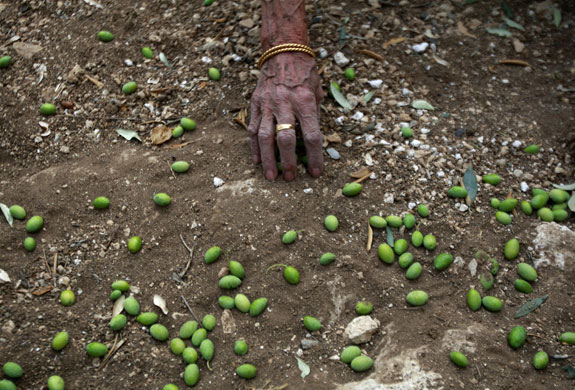
If you showed an image of a poor old woman today and captioned it “crone,” you would rightly catch hell. But this photo is close to that. We see the old woman’s hand scratching across the dirt for the pistachios, as if to furtively grasp her widow’s mite. She might actually be a person of considerable status and wisdom, as the caption merely said that the nuts had been spilled, but the photograph alone presents a social type, not a person. As above, there is a hint of culture (jewelry, like the pottery, is the basic stuff of museum collections), but this is an image of bare life.
Note the same elements predominate in this image:
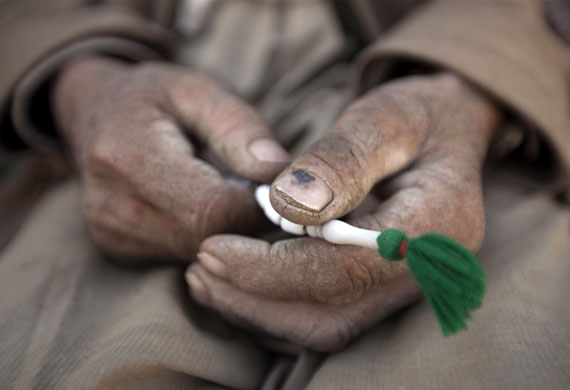
Again, a rudimentary sign of culture (the prayer beads) serves to emphasize the dirty hands and rough clothing of someone living in a world of manual labor. The worn nail is particularly harsh–like the first hand, some wearing process pushes the viewer back into nature, into a visceral, painful, inevitable mortality. Religion seems an obvious consolation, and so, once again, a person and his society are denominated as essentially simple, pre-modern, and located within conditions and cultures that are changeless.
All three photographs appeared in slide shows at major newspapers this week. None of them were taken with the intention to demean their subjects. Nor do they, by themselves. But surely one cumulative effect is to further consolidate a cultural geography that places some people in a modern world of continuous change while keeping others in a timeless realm where survival for another year is thought to be enough.
This fragmenting vision is wrong, of course, but more than that, it is a morally flawed pattern of denial. Instead of reproducing images that make poverty seem timeless, there is need to recognize that everyone lives in history. Only then can one fully understand how all are connected in a web of obligation, and why continued suffering is a collective failure, not least by those most capable of being agents of change.
Photographs by Arko Datta/Reuters, Ahmad Gharabli/AFP-Getty Images, Ahmad Masood/Reuters.
SIght Gag: Can You Find the Obama "Birther"?
Credit: Benson/Arizona Republic
“Sight Gags” is our weekly nod to the ironic and carnivalesque in a vibrant democratic public culture. We typically will not comment beyond offering an identifying label, leaving the images to “speak” for themselves as much as possible. Of course, we invite you to comment … and to send us images that you think capture the carnival of contemporary democratic public culture.
Photographing Poverty: Realism or Sentimentality?
Debates about the moral value of photography have to deal with poverty. One might think that there is little to discuss: poverty can be distressingly visible, and photographs have been a principle means for motivating efforts to help those in need. From the classic photographs by Jacob Riis and Lewis Hine to those persistent Save the Children ads, images of poverty and particularly of its effects on children have raised awareness, shaped public policy, and opened pocketbooks. All that remains, one might think, would be to continue to produce compelling images of destitution.
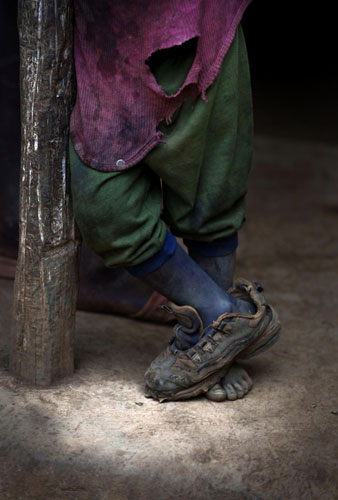
This photograph from Haiti may not prick one’s conscience, perhaps because we can’t see the child’s face, but it remains a striking image. It also reflects the other side of the debate about photography’s moral legitimacy. One argument against the image is that the photographic depiction of poverty is in fact highly sentimentalized: a continuation of the stock attitudes–including charity, but also condescension–of the Victorian era. In short, the photograph of the poor child is a transposition of the Victorian waif from illustration into photography. For this and other reasons, photographers such as Gordon Parks and others have been accused, not entirely without cause, of simplifying or otherwise aesthetically framing poverty as an object for concerned contemplation, instead of either exploring the social fabric of the poor community or exposing the causes of its continued oppression.
This photo would seem to fall under that criticism. The image is too good: on the one hand, a near-perfect outline of the waif and, on the other hand, a composition of elegant design and rich colors that belies the child’s lack of resources. Indeed, it could be in a Renaissance painting, and both the cropping and the oddity of the one shoe draw one into a close study of the image itself and thus away from critical attention to the social and economic conditions that lie behind it.
The photograph may reflect another criticism as well. Somewhat paradoxically, photography is faulted (and by the same people) both for not evoking the correct moral response and for wearing out compassion or other charitable or progressive inclinations. (Save the Children does come to mind.) That idea could drive photographers to look for new angles on an old subject, and the image above certainly has been cropped in that manner. Instead of the typical dirty face, we see asymmetrical feet (one shod and one bare); instead of the usual sense of need, there is a strange self-sufficiency in this child’s pose; instead of the same assurance that everyone knows what is needed, wearing one shoe creates a whiff of illegibility. And so a photo that may be making poverty into art could also be reworking viewing habits to suggest that seeing is not knowing.
The debates about photography are not going to be resolved today. I don’t think one can or should avoid the work done by public art, which includes channeling sentiments and thus risking sentimentality. Photojournalism does traffic in stock sentiments, just as intellectuals rely on stock criticisms. I’ll admit that there are days when I side with Oscar Wilde’s comment that “One must have a heart of stone to read the death of little Nell without laughing.” But there is still reason to take a good look at the other side of privilege, and to consider how compassion must at some point be a way of seeing.
Photograph by Ramon Espinosa/Associated Press. (This post is the second this week on channeling 19th century public art; the first is here. Another relevant post is here.)
19th Century Public Art in 21st Century Photography
The Statue of Liberty is open for business again for the first time since 9/11. As a result, New York photographers have had to deal with the task of finding a distinctive angle on one the the most familiar images in public art. This one shows the lengths we all are expected to go to see the icon anew:
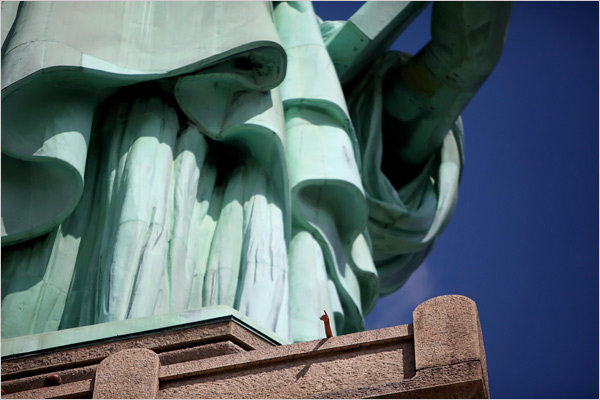
A child’s arm points upward while the massive statue looms above. The photo is not likely to find its way into a photography textbook: we see nothing whole but instead only a truncated pedestal, sectioned statue, and disembodied person. You have to peer into the image to locate the child’s small arm, which then makes the statue’s bulk all the more overpowering. Distinguishing features are cut out of the picture while proportion is mangled. In its place, attention is drawn to the institutional concrete and the heavy metalwork, and to the fragility and impermanence of the child’s limb.
But the photo is not cutting anything down to size. Instead, it may be depicting a relationship between the national icon and the viewing public. Note now the child’s arm is reproduced by the arm of the statue. This is the only correspondence visible between the living person and the icon. The parallelism is likely to be symbolic: and so, just as the statue is a token of America’s past, so is the child a sign of its future. As both are aligned, and as the one is there to provide inspiration to the other, the implication is that America’s future will continue to be true to the ideals and aspirations of its past.
At this point, some would quote the text at the monument, say, about “huddled masses yearning to breathe free,” but my point is not to endorse a specific sentiment. I do want to suggest, however, that the sentimental work of the 19th century public artwork is being continued today in two registers–by the statue itself and by its photographic reproduction. Neither is innocent of complicated motives, but if you accept (as I do) that democracies depend on sentiments just as they depend on critical reason, then it is interesting to see how public arts continue to evoke such admittedly formulaic emotions. Sometimes photography simply relays another artwork and much of the time it draws on its own iconography. The image above does some of each.
An image of obvious fragmentation should also alert the viewer to its own limitations. This view of the national monument makes it seem even more, well, monumental, while reducing actual citizens to the miniaturized status of a small child who can, of course, do little more than look and point. The state may loom too large, and the people are now all but invisible individuals and certainly not masses that might be not so much huddled as unionized. But perhaps that is too much of a stretch. On the other hand, if we are to follow the lead of the photographers, we should be willing to consider more than one angle on our national icons, and on the state of the union they represent.
Photograph by Nicole Bengiveno/The New York Times.
Ritual Violence and Accidental Symbols
I thought it was the hand of a priest:
Protestant upbringing + Lent + gold embroidery + blood + cross = mistaken perception based on murky tales of medieval cultic practices involving lurid displays of mortification. From there it’s a quick step to announcing that, once again, the church has blood on its hands.
In fact, the cross is not even a cross. And the priest is a matador. The matador’s hand is holding one of his swords, one obviously still sticky with the bull’s thick blood.
But one could say that this is not a sword. For anyone familiar with Christian iconography, the sword could very well double as a cross, and as only a cross, and particularly when smeared with blood. If the imagery seems medieval, that might say only that the medieval artists behind the allusion got it right. If so, the spectator should also be seeing the blood of Christ; if applied to the bullfight, the point would be to believe that God cares not for the supposed triumph in the ring but for the poor animal as it suffers and dies.
Those in the arena will have seen something else as they appreciated the choreography of that ritual violence. The photo captures some of that drama, beginning with the blood bonding of the ornately clad matador, embodiment of art and civilization, with the animal nature of the bull. The antique weapon, gilded clothing, and refined use of the hand together create a charmed circle of performance within which the blood can flow, again and again and again.
That is not the only example of ritualized violence, however.
It could be the hand of a penitent, or of a priest preparing to administer the Host, or of a beggar, or someone about to give a blessing. It is not a hand, however, but a dead hand. There is no blood, but someone was slaughtered in public much like any bull in a ring. There are no vestiges of the middle ages, as this is a thoroughly modern scene with plastic tarp and aluminum hardware. But it is ritualized for all that. Another terrorist bombing in Sri Lanka, an act of violence so common that they have developed little metal fixtures for managing the forensic investigation.
And not without symbolism. That number six refers to a segment of the crime scene marked for photographic identification, yet it signifies more as well: there were others, there will be others, we’re each just a number, take a number and wait and your number will come up soon. There is no blood, but this bureaucratic item is equally horrific. We are supposed to believe that although the killing continues, everything is under control. Everything is not under control. And in a world of ritualized violence, accidental symbolism may be one way to get back to the suffering.
Photographs by Daniel Ochoa de Olza/Associated Press and AFP/Getty Images.
What if God Counts?
So Hamas and Israel both wanted war and each got their wish. The war was no surprise when it came and the outcomes are predictable as well. Israel will use its overwhelming military superiority to smash enemy infrastructure while also killing many civilians, which will allow Hamas, broken but not destroyed, to claim moral and political victory. The international community will broker another truce, the band-aid of humanitarian aid will be restored, rocket attacks on Israel will diminish for awhile, and the occupation policies that have turned the West Bank and Gaza into prisons will continue. A rejuvenated IDF will claim that it did indeed, as the Defense Minister promised, restore “peace and tranquility,” a phrase notable for not including the word “justice.” Then the rocket attacks or suicide attacks will resume, Israel will again be given the worthless admonition that it should allow itself only a proportionate response–which, technically, would be firing rockets at civilians–and so it goes. It is tempting to simply say, “a pox on both your houses.” But then there is this:
A child’s arm protrudes from the rubble of a building destroyed by an air strike. This is one death among many–500+ civilians and counting–including perhaps the woman whose half sandal also is in the picture. It is one picture among many, and one of of the least dramatic, but I can find no other that so eloquently communicates the crushing sorrow of war’s devastation. The mass of concrete crushing the child also completely crushes any hope. This is not a scene of rescuers digging frantically in a race against time. Instead, the several adults simply stand there, helpless. It’s as if they are granting the child a last moment of dignity before they have to tear the broken body out of one grave only to return it to another.
This is why we shouldn’t turn away or throw up our hands in disgust. Each death is a separate tragedy, not merely another datum to be aggregated into the geopolitical assessment. But it is not enough to mourn the individual loss of life if that does not also include a commitment to facing the deep causes of this war and the other wars now underway–most of them killing far more people than will die in Gaza. Precisely because each death is so wasteful, unnecessary, and immoral, it should be counted in another sense: as a measure of collective political failure.
Let me put it this way. What if God counts? (I realize that belief in God is rather difficult these days, but let’s at least consider the idea a useful fiction.) What if, that is, God judges not so much by weighing reasons but simply by how many are harmed? It makes sense, if you think about it. God (for example, in Judaism, Christianity, and Islam, just to name a few religions) is supposed to see through our social identities, our many rankings and all the aggrievements they involve. God calls on us to transcend social ascription and avoid false pieties and idolatries, all on behalf of living in justice and compassion with one another. Nor has divine judgment ever given points for wealth or firepower, or for sacrificing children for one’s cause. The more I think about it, the more clear it seems: God would put great weight on how many were harmed, and what was done on all sides to prevent harm, while being much less concerned about who had the better rationale on any particular day.
Think about it: not what you intended, and not whether you were right, but simply how much damage you caused. Relentlessly counting while turning a deaf ear to our many arguments, no wonder God’s judgment is said to be so terrible.
In the short run, it would seem that God’s judgment should fall on Israel: a handful of deaths on one side and hundreds on the other, not to mention the continuing toll taken by the occupation. But that may be too simple. Surely God also follows the money, which goes back to the U.S. on one side and sources throughout the Arab world on the other side. And this is a small war by comparison with the American wars in Iraq and Afghanistan and even more so compared to the wars raging across central Africa. Again, war is a collective failure, and ultimately the judgment rests on us all.
Photograph by Mohammed Abed/AFP-Getty Images.
